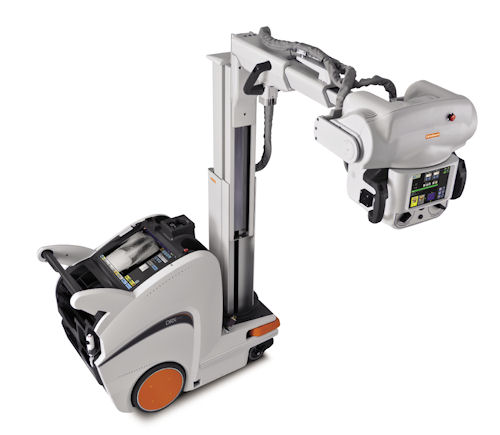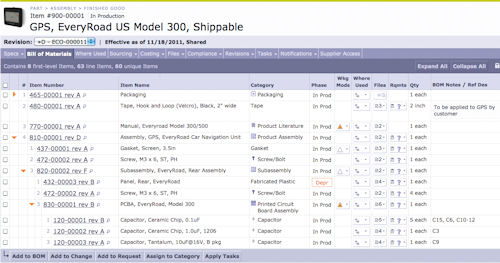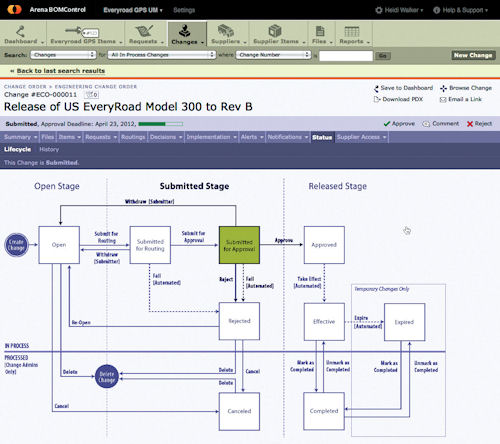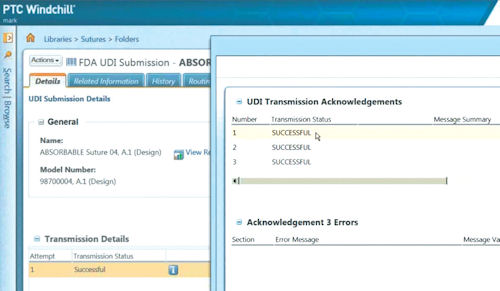December 4, 2001
By Mark Clarkson
There’s a joke in the medical devices industry that it takes three engineers to design anything. The first engineer defines the functional requirements, the second engineer creates the actual design and the third engineer is there to verify that the second engineer does what the first engineer tells him to. Thanks to the regulations specific to medical devices, the joke is not much of an exaggeration.
 Carestream’s DRX Revolution Mobile X-ray System is a Class II medical device. Image courtesy of Arena Solutions. |
“If you ask an engineer how long it will take to implement an idea on a medical device,” says Arena Solution’s Yelena Bolton, “they will tell you, ‘one day without the paperwork and three days with the paperwork.’”
To help them deal with all of that paperwork, much of it to comply with US Food and Drug Administration (FDA) regulations, many medical device manufacturers turn to engineering services providers to help them organize their design, simulation and test data. Additionally, software providers have developed specialized solutions to help design teams manage the various sets of data needed to comply with medical device manufacturing regulations.
Device Classification
The extent of regulation depends on the actual type of medical device we’re talking about. In the U.S., medical devices are divided into three broad classes. Class I devices are the simplest—tongue depressors, bandages, crutches and so forth. Class II devices include monitoring equipment, X-ray machines and infusion pumps. Class III devices include those that are implanted in the human body, such as pacemakers and heart stents. Regulatory agencies like the FDA get quite persnickety about implanted devices. You need to be very sure you have all your ducks in a row; and be prepared for more ducks on the horizon.
Unique Device Identifiers
For example, starting September 24, each Class III medical device will have to carry a unique device identifier (UDI). The UDI is an FDA mandated 14-digit number that provides a way to identify each model, and for any versions or variants of that model, all the way down to different packaging configurations.
“There are 62 different pieces of data that need to be submitted to the FDA along with that 14-digit identification number,” says PTC’s Jill Newberg. “It’s a whole new data management problem. The FDA says, starting September 24, every time you make a change to a Class III product that affects any one of these 62 points, you’ll need a new or revised UDI submission.”
You can enter this More Information on the FDA’s web site, manually. But for a company of any size, which may have thousands of versions and variants of products, that’s not really practical.
“That’s where a UDI solution like ours comes in,” says Newberg. “We handle the data management problem of gathering all these unique data points ]and] communicating them to the FDA. And then we can track responses and let your know where you stand, compliance-wise, across your product range.”
UDIs are just one of an array of special forms, regulations and requirements for which product lifecycle management (PLM) vendors offer special solutions. If you want to sell your products globally, you’ll need to conform to a whole raft of new regulations for every market.
Seeking Validation
Even the PLM software itself has to meet special constraints and regulations in the medical device space. “Everyone verifies their software before they put it on a CD,” says Arena Solutions’ Steve Chalgren. “But then, when the medical device customer installs it on their server, they have to validate that it actually works as they intended it to, that it meets the functional requirements that were defined in the product. Validation is an extra step the FDA requires for medical device companies.”
 Viewing an Indented BIll of Materials in Arena PLM. Image courtesy of Arena Solutions. |
 Viewing a Change Order’s Lifecycle Phase in Arena PLM. Image courtesty of Arena Solutions. |
Now, if you lay a finger on the software, even to apply a small hot fix, it’s got to undergo some form of re-validation.
“I’ve seen the cost of validation for a service pack run to $50,000 or a $100,000,” says Chalgren. “The result is that medical device manufacturers don’t upgrade very often, so they get way behind on the tech.”
Arena is a cloud-based PLM solution. “That’s how we solve it,” says Chalgren. “Our software is just one install serving hundreds of customers, so we can validate that one instance and charge each of our customers a slice of it.”
More Than Just Breadcrumbs
“The way a regulatory body looks at it,” says Integware CEO Chris Kay, “is that they’re enforcing good manufacturing processes. When you’re implanting something in your body, you want to know that the company that’s building that product has followed a set of best practices for how they should manufacture it, and kept track of quality issues and design changesthat they’re following good manufacturing practices. And these regulatory agencies are entrusted to ensure they’re following good manufacturing practices.”
Those regulatory agencies are also very interested in exactly how you handle serious complaints, failures and other problems. Serious problems result in corrective actions. “It’s a formalized quality process,” says Kay, “for understanding all the criteria that led to the issue, getting to root cause, determining the countermeasures, putting those countermeasures in place, and releasing those to the market.
“Once you determine what changes need to be put in place to address the ]root of the problem,] it will most likely generate multiple change orders,” Kay says. “How do you trace that corrective action to those change orders? What changes were made? Why? Who made them? And were the ]people] approving the change authorized to both review and approve of that change?”
The FDA is going to want to trace the root of the problem all the way back to the initial design requirements. Depending on how serious and widespread the problem is, a corrective action could be open for months or years before it’s resolved.
And yet, says Kay, “many medical device companies still use a phenomenal amount of paper. Without something like PLM, which provides traceability between their product data and also their quality data, they’re forced to rely on multiple repositories of disconnected and duplicative data, and to keep it all in synch.”
 The PTC UDI Solution tracks submissions to the FDA as well as communications from them. Image courtesy of PTC. |
“It’s important to minimize the number of databases and point solutions that people across the company have to go to to get their jobs done,” says Carestream’s David Sherburne. “There’s always opportunity for manual error when people are going to multiple places for More Information.” Carestream, a manufacturer of medical and dental imaging equipment, is in the process of expanding its PLM implementation to absorb numerous local, manual and point solutions. It’s a tall order, and the obstacles aren’t all technical.
Licensing
Just budgeting for a PLM system can be surprisingly problematic, Sherburne says. “License models are very convoluted. With some suppliers, we had to predict where our user would be located, what modules they would use, and whether they would be consumers or producers of data. If you have a few thousand users and you try to figure out where they are and what they might be doing in the system, it becomes almost impossible to look at what your license cost would be.”
Ultimately, Aras’ subscription model worked for Carestream. It provided a predictable business model that allowed expansion and access the key requirements of a PLM platform.
The benefits of PLM are hardly restricted to medical device manufacturers. “I’ve yet to meet a customer that doesn’t care about their product quality,” says PTC’s Tom Shoemaker. “But ]with medical devices] there’s a very regimented way things need to be done and tracked. There needs to be a trail in place to prove what path you took.”
Contributing Editor Mark Clarkson is DE’s expert in visualization, computer animation, and graphics. His newest book is Photoshop Elements by Example. Visit him on the web at MarkClarkson.com or send e-mail about this article to [email protected]
More Info:
Aras
Subscribe to our FREE magazine, FREE email newsletters or both!
About the Author
Mark ClarksonContributing Editor Mark Clarkson is Digital Engineering’s expert in visualization, computer animation, and graphics. His newest book is Photoshop Elements by Example. Visit him on the web at MarkClarkson.com or send e-mail about this article to [email protected].
Follow DE





